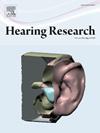耳毒性药物对回声定位蝙蝠回声定位频率改变和听力损失的影响
IF 2.5
2区 医学
Q1 AUDIOLOGY & SPEECH-LANGUAGE PATHOLOGY
引用次数: 0
摘要
噪声暴露会增加耳蜗外毛细胞(ohc)中的活性氧(ROS)水平,从而损害ohc并导致噪声性听力损失。然而,越来越多的证据表明,回声定位蝙蝠在强噪声暴露后仍能保持其听觉敏感性,这表明它们具有很强的清除ROS的能力,或者噪声暴露不会增加动物耳蜗中的ROS水平。为了区分这些可能性,研究人员向恒频调频蝙蝠(希波希德罗斯普拉蒂)腹腔注射了耳毒性药物卡那霉素,该药物可增加其他哺乳动物耳蜗中的ROS水平。结果表明,卡那霉素有效地改变了回声定位频率,改变了听觉脑干反应阈值,并破坏了OHCs,表明回声定位蝙蝠对耳毒性药物敏感。因此,H. pratti似乎不能有效清除ROS,回声定位蝙蝠对噪音暴露的敏感性降低可能是由于噪音暴露未能增加耳蜗中的ROS水平。此外,我们的数据还显示,使用卡那霉素损伤听觉灵敏度后,静息频率(RF)的精度大大降低,表明RF的精度依赖于听觉反馈。这些发现可以为理解回声定位蝙蝠的听觉系统对强声环境的适应机制提供见解。本文章由计算机程序翻译,如有差异,请以英文原文为准。
Echolocation frequency alteration, and hearing loss induced by an ototoxic drug in the echolocating bat Hipposideros pratti
Noise exposure increases the level of reactive oxygen species (ROS) in the outer hair cells (OHCs) of the cochlea, which subsequently damages OHCs and causes noise-induced hearing loss. However, increasing evidences have shown that echolocating bats can maintain their auditory sensitivity after intense noise exposure, indicating that they have a strong capacity to clear ROS, or that noise exposure does not increase ROS levels in the cochlea of the animals. To differentiate between these possibilities, the constant frequency-frequency modulation bats, Hipposideros pratti, were intraperitoneally injected with the ototoxic drug Kanamycin, which increases ROS levels in the cochlea of other mammalian species. The results showed that Kanamycin application efficiently altered the echolocation frequency, shifted the auditory brainstem response threshold, and damaged the OHCs, suggesting that echolocating bats were sensitive to ototoxic drugs. Therefore, H. pratti does not seem to be able to clear ROS efficiently, and the decreased susceptibility to noise exposure of echolocating bats might be due to the failed increasement of ROS levels in their cochleae by the noise exposure. Furthermore, our data also showed that the precision of resting frequency (RF) was greatly decreased after the auditory sensitivity was impaired by Kanamycin application, suggesting that the precision of the RF was dependent on the auditory feedback. These findings could provide insights to understand the adaptation mechanisms of the auditory system of echolocating bats to intense sound environments.
求助全文
通过发布文献求助,成功后即可免费获取论文全文。
去求助
来源期刊

Hearing Research
医学-耳鼻喉科学
CiteScore
5.30
自引率
14.30%
发文量
163
审稿时长
75 days
期刊介绍:
The aim of the journal is to provide a forum for papers concerned with basic peripheral and central auditory mechanisms. Emphasis is on experimental and clinical studies, but theoretical and methodological papers will also be considered. The journal publishes original research papers, review and mini- review articles, rapid communications, method/protocol and perspective articles.
Papers submitted should deal with auditory anatomy, physiology, psychophysics, imaging, modeling and behavioural studies in animals and humans, as well as hearing aids and cochlear implants. Papers dealing with the vestibular system are also considered for publication. Papers on comparative aspects of hearing and on effects of drugs and environmental contaminants on hearing function will also be considered. Clinical papers will be accepted when they contribute to the understanding of normal and pathological hearing functions.
 求助内容:
求助内容: 应助结果提醒方式:
应助结果提醒方式:


